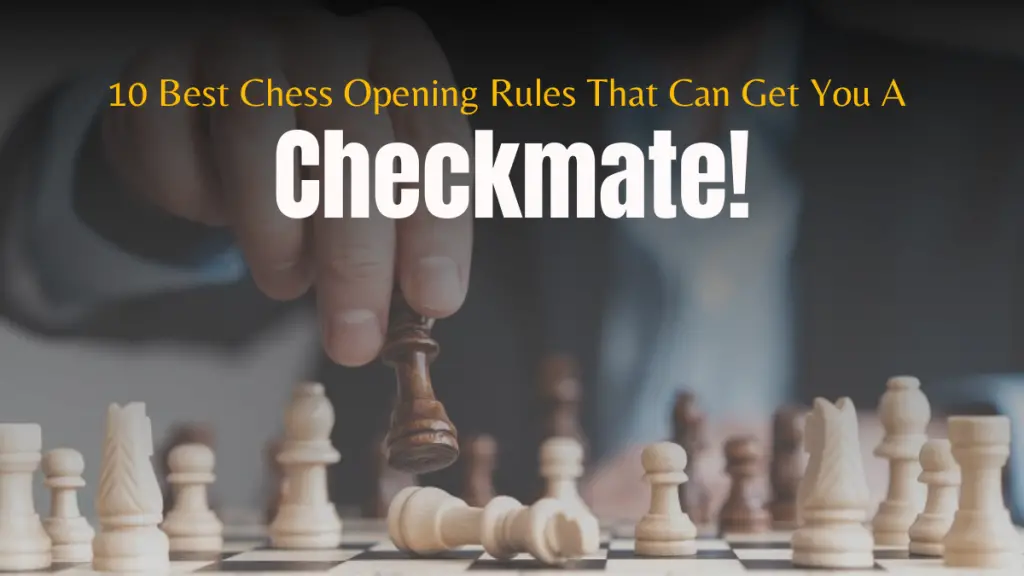
Your classic checkmate is largely determined by how smart your chess opening is. The establishment is what decides your middlegame and endgame.
The initial stage often referred to as chess opening, book moves or just books have a great influence on how the game develops and who takes over. So, it is of utter importance to make your first move like a pro.
While there have been hundreds of counters against the essence of chess openings, you should follow these 10 best chess openings until you are before a master at your own game.
Let me help you play the masterstroke with these 10 chess openings which will definitely get you a checkmate.
Chess Opening Rules
1. Open with a Centre Pawn

Chess opening basics say that you should always open with a centre pawn. This pawn will be open taking control of the centre and will have a good space to play its own game.
In fact, most of the advanced players have also dreamt of attaining the perfect centre pawn position. It also remains one of the many factors the affects the opponents positioning. If your pawn gets to capture the centre of the game, it is mostly considered as a winning state.
Make sure that you always open with a centre pawn.
2. Develop Each Piece before Threats
Developing your pieces comes under one of the most important chess opening strategies and it helps each warrior get ready for battle. Most chess beginners end up moving a few pieces here and take others out only when these pieces are under threat.
If you want a winning game, move all your pieces synchronically. Time is the ruling factor of chess opening and if your opponent ends up strategically leading in the development, you are in for a loss.
Stay ahead in the development and if you are opening for white, you already have the brownie points.
But this directly brings me to the next point…
3. Don’t Let Your Pawn Make Too Many Moves
Like I said before, time is the essence of the game but most of the players waste their time by making silly pawn moves during the chess openings.
The basic principles and chess opening strategies always say that although it is a good idea to move a couple of pawns, do not overdo it.
Your main idea of moving the pawn should only be to make space for other pieces to come out and castle up.
Simply moving the king’s pawn two squares gives way to the queen and the kingside bishop, which is a fair deal for chess opening for beginners.
4. Have Patience with The Queen

Don’t bring your queen out too early – one of the important chess opening tactics.
I know, while I say that developing pieces is crucial to chess openings, it definitely does not be that you bring out your queen in haste. In the kingdom of chess, the next quintessential piece is the queen (first being the king, of course silly) and cannot lose her.
Before queen there are approximately 14 pieces that can give their life for the queen but gambling her without a strong reason may be a mindless move.
If you bring her out, the opponent would strategies to kill her leaving no room for development for you.
5. Moving The Same Piece Twice Is A No!
Moving the same piece and letting the other rest is not a wise chess opening. It is not only a waste of time but also affects the development process majorly.
The only best reason to move the same piece twice is to capture the opponent.
It is a warlike scene and you cannot really rely on a one-man army, can you?
It is important to strategize each piece of your board game and to make moves that are only establishing your middlegame and do not break it.
It is often better to keep developing your pieces rather than going pawn hunting during chess opening. Underdeveloped teams and hungry pawns can invite trouble.
6. Castle, Castle, Castle as Early as Possible
The development calls for pieces in action but it also attracts a lot of vulnerability for the king. If you have a strong opponent who knows what he is doing, it is going to be a difficult time for your King.
Avoid being a victim of checkmate in the opening itself and try to develop pieces in a way that brings your King hostage. Make sure your King gets castled before your 10th move.
It is also a classic move that helps your rooks take control of the centre of the board and charge the opponents king if he has forgotten to castle him.
7. Always Target The Centre
If you have captured the centre with your chess opening moves, voila! It is a victory for you. Always try to develop your pieces towards the centre.
It has been one of the most ideal situations and 80% of the time invite victory to your King. The squares e4, d4, e5 and d5 are high ground and this is how the ideal situation looks like.
Although the whites are not in the centre and it is more of a fantasy come real, this seems to be the most politically correct positioning for a win.
While your opponent would also try to control the centre of the board, and you may have to sacrifice a few best spots to them but that shouldn’t stop you from not capturing the centre.
8. Try To Leave One Centre Pawn In-Charge
It may be a good dream like the situation to own the centre but even if you can’t, try to maintain on pawn in the centre.
The centre pawn decides the trajectory of movement for your opponent. If you have a pawn in the centre, the opponent can only approach your King by encircling through the flanks.
But if you do not have pawns holding the middle-ground, it is very easy to access the King leaving him in a vulnerable position.
Pawn is like cement walls for the opponent to jump and enter your compound. Interestingly, if your pawn holds well in the centre, it is also easy for your Rooks, Bishops, and Queen to finish the enemy on each side of the board.
It is always a great idea to have at least one pawn in charge of the centre and developing it during your chess openings is important or you may lose it to the enemy.
9. Don’t Sacrifice without a Strong Reason
How would you feel if you are in a real war-like situation and you keep losing men without having anything in return? The term martyr has a reason behind it. Only sacrifice for a bigger motive.
The ultimate goal in chess is to achieve checkmate and sacrifice should always mean having a motive of gaining strategic positioning or compensation in a tactical form. Especially in chess openings, you cannot sacrifice a piece for a gag.
It should be a deliberate exchange of low-value chess pieces for the opponent’s higher value chess piece.
Putting your pieces off balance in the chess opening book is not only an unpleasant way of development but it can also take your precious time.
10. Back-Up and Connect Your Rooks
Have a clear space between them so that they can back the other rook up when they come across a threat.
Move all your pieces out and castle the king. Keep space around it so that they can move back and forth either to defend or to support.
I would personally suggest bringing them up to the centre just like the ideal position but another idea can also be to put it opposite the enemy queen in order to make a solid back rank.
With this, the chess opening basics and principles come to an end.
Over To You
These are the 10 best chess openings principles that can make help you become a chess champion. However, the most important practice of opening chess remains development.
The better your development strategies in the book moves, the more chances you take over by the middle game.
Although every chess game is unique to it, the chess opening decides your fate! Make sure you get the best out of it.
